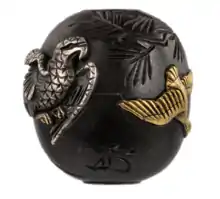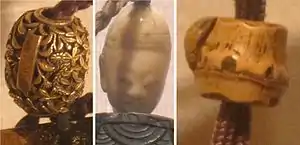Ojime
An ojime (緒締め, lit. "cord fastener") is a bead used in Japanese inrō (carrying cases). It is typically under an inch in length. Each is carved into a particular shape and image, similar to the netsuke, though smaller. It is used to fasten the cord of the inrō so that it does not unstack while carried.

A Japanese 19th-century mixed metal ojime bead

A Meiji gilt bronze pearl-inlaid ojime

Ojime at the Honolulu Museum of Art
The history of ojime beads dates back to the Edo period (1603-1868). Ojime beads, netsuke, and sagemono or inrō cases would be items worn on a traditional kimono, typically hanging from the belt.[1]
This article is issued from Wikipedia. The text is licensed under Creative Commons - Attribution - Sharealike. Additional terms may apply for the media files.
